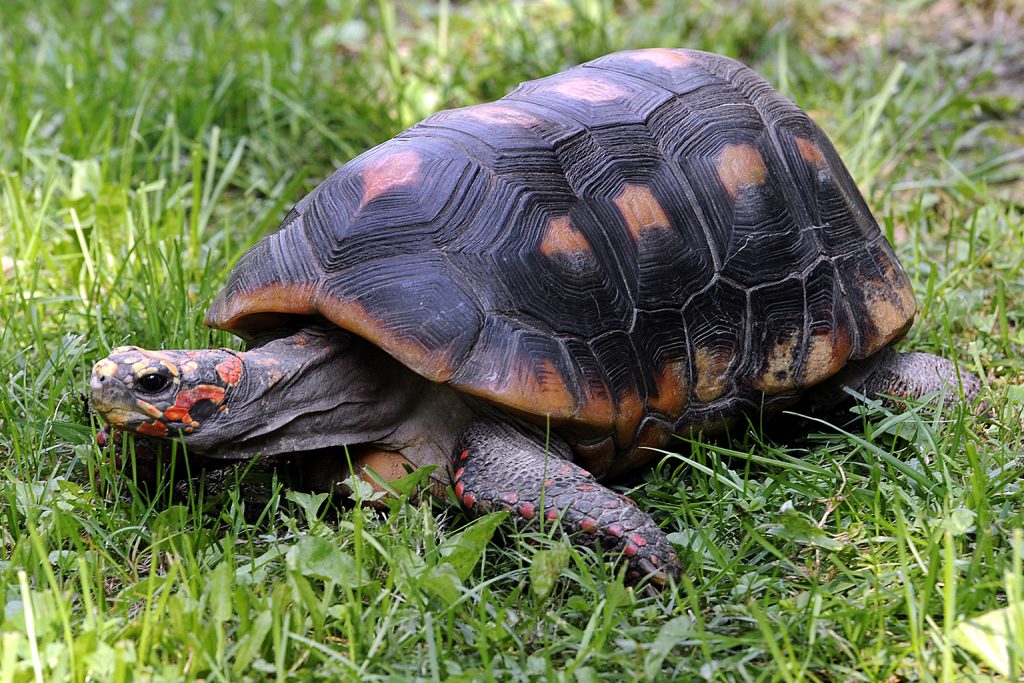Overview
“Where I live”
Native to Central and South America, red-footed tortoises inhabit tropical forest and open grasslands.
The Maryland Zoo features red-footed tortoises among its Animal Ambassadors, which are introduced to audiences in education programs on and off grounds.
“How I live there”
Red-footed tortoises are most active during the day and immediately after rain. They are inclined to be passive and locally nomadic. They wander in search of food and are not territorial. The only time that red-foots may become aggressive toward each other is during breed season when males are competing for females.
Red-foots, like other tortoises, are primarily vegetarian. They eat mainly fallen fruits, flowers, wild vegetables, grasses, and fungi, and may supplement their diet occasionally with carrion. They rely upon their keen sense of smell to locate food.
In response to cool weather, red-foots can survive on minimal food because their metabolism slows. When the temperature drops into the 60s, for example, a full-grown red-foot can survive nearly a month on a single banana!
“Making my mark”
These black-skinned tortoises are tattooed with splatters of red on their feet and yellow on their heads. They weigh about as much as a pet cat. As males mature, they develop a distinctive hour-glass shape. Seen from above, they look like they have a waistline.
“What eats me”
Adult red-footed tortoises, like most tortoises, have few natural predators other than humans. This is because they move through life in full body armor and can withdraw into their shells when threatened. Eggs and hatchlings are extremely vulnerable to predation, however.
Raising Young
After mating, when ready, females dig a hole in the ground or clear a patch of leaves on the forest floor and deposit their eggs. They cover up the eggs and then walk away and have nothing more to do with raising their offspring. The eggs incubate for 3 to 7 months, and the temperature of the surrounding leaves or soil determines the sex of the hatchlings. Hatchlings dig their way out of the nest and are immediately on their own. Few survive to adulthood but those that do may live half a century or more.
Conservation
Red-footed tortoises have not yet been evaluated by the IUCN, the world’s leading conservation organization. However, they are protected under Appendix II of the Convention on International Trade in Endangered Species (CITES), which means that they cannot be exported from any home country without a permit. In several countries, they are also being protected through the conversion of land into national parks and private reserves, which results in habitat preservation. Traditionally, these tortoises have been most threatened by habitat loss and by over-hunting and over-collection. Throughout much of their native range, their meat is considered a delicacy. Because they don’t put up a fight, they are also easily caught and sold illegally as pets.
Taxonomy
- Kingdom: Animalia
- Phylum: Chordata
- Subphylum: Vertebrata
- Class: Reptila
- Genera: Chelonoidis
- Species: carbonarius
What is an Animal Ambassador?
The Maryland Zoo refers to its special collection of education program animals as “Animal Ambassadors.” The Zoo currently cares for more than 60 Animal Ambassadors, representing more than 40 species, both native and exotic. These animals are managed separately from the rest of the Zoo’s collection and cannot be seen on exhibit at the Zoo. However, many can be seen up close and personal on a rotating basis at Creature Encounters, the Zoo’s outdoor education center; at camp and school programs at the Zoo; as featured participants in community-based Outreach programs; and at special events on and off Zoo grounds.
Animal Ambassadors spend countless hours working with their human handlers, developing bonds of trust and communication that will allow them to appear in front of audiences large and small. They are not show animals. They behave naturally, focusing audiences’ attention on their natural behaviors and adaptations and giving living, breathing meaning to concepts and topics that students may be studying.
Animal Ambassadors travel all over the state of Maryland and beyond, and many also make local and national media appearances, educating about wildlife while representing the Zoo and its commitments to animal welfare and conservation.
What is The Animal Embassy?
The Animal Embassy at The Maryland Zoo is an off-exhibit area that is not open to the public. It is where the Zoo’s “Animal Ambassadors,” or education program animals, live. The Embassy is home to more than 60 individual animals representing more than 40 different species. It is staffed by its own dedicated group of keepers and volunteers and has both indoor and outdoor living space for the animals.

